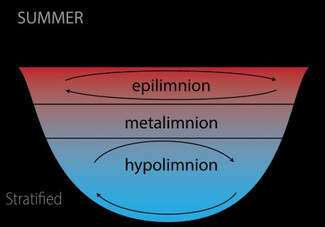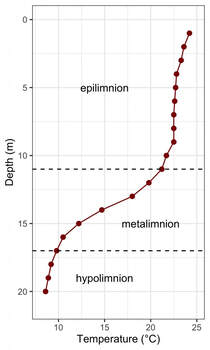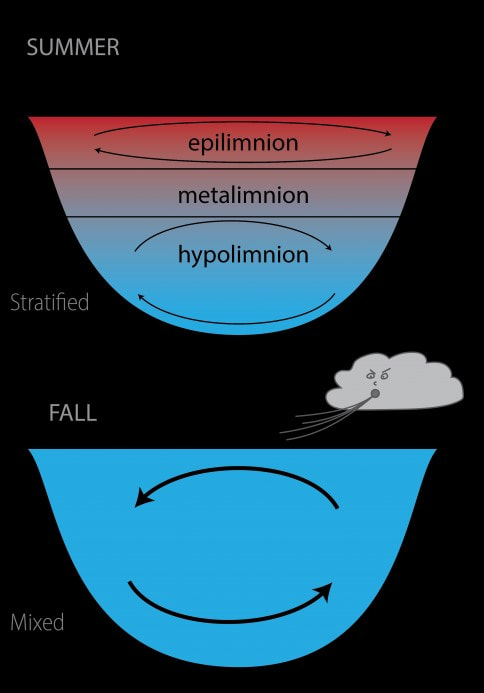Lakes are like onions...they have layers!
Thermal stratification
|
It is common for lakes in temperate regions to thermally stratify during the summer, forming separate layers based on temperature.
During the summer, sunlight warms the surface waters of the lake. This warm, top layer is called the epilimnion (the Greek term for "top lake"). The water begins to cool rapidly at the depth that sunlight no longer penetrates. This rapid change in temperature is called the thermocline. The thermocline defines the middle layer of the lake, called the metalimion (or "middle lake"). The water below the thermocline is called the hypolimnion (or "bottom lake"). This layer is colder than the surface. These layers remain distinct because the warm water of the epilimnion is less dense than the cold water of the hypolimnion. This is similar to oil floating on top of water. The water of the epilimnion and hypolimnion do not mix when the lake is stratified. The depth of the epilimnion depends on how far the light and heat from the sun can penetrate into the water column. Clear lakes may have a deeper epilimnion that murky or turbid lakes. |
Lake layers formed during summer stratification. Image credit: Hilary Dugan. https://dugan.limnology.wisc.edu/limnology-figures/
Temperature profile of a stratified lake. Image credit: Hilary Dugan. https://dugan.limnology.wisc.edu/limnology-figures/
|
Lake Turnover
|
Fall turnover. Image credit: Hilary Dugan. https://dugan.limnology.wisc.edu/limnology-figures/
|
Summer stratification of temperate lakes breaks down in the fall. The sunlight is not as strong and the winds typically pick up. The epilimnion begins to cool and extend deeper into the lake.
As the difference in temperature between the epilimnion and the hypolimnion shrinks, the density of the water in the two layers becomes more similar and the water can mix more readily. Fall turnover occurs when the water through the entire depth mixes. There is no thermocline or metalimnion during this time. Turnover typically occurs in the fall and in the spring after ice off. Turnover is important because it brings nutrients and materials from the bottom waters to the surface waters, feeding algae and other organisms that are abundant in the sunlit regions of the lake. |
Location |
|


